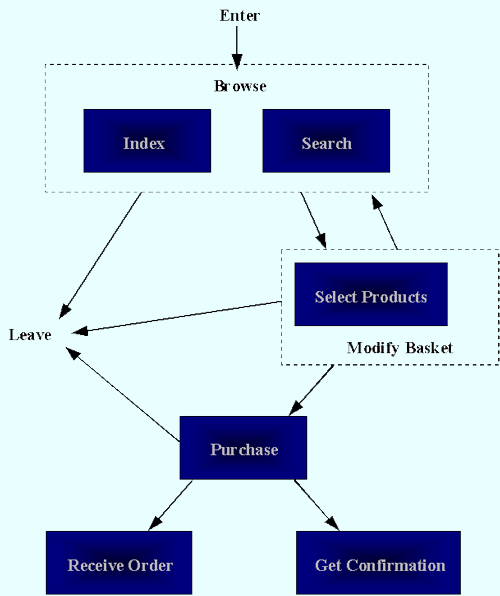| ASP Name |
Description |
Section |
| Footer.asp |
This is included at the bottom of every
display page. It provides the closing structure for the navigation
and primary content area. |
Building the User Interface
Chapter 6 |
| Header.asp |
This is included at the top of every
display page. It provides the navigation structure. |
Building the User Interface
Chapter 6 |
| AddItem.asp |
Adds items to the shopping basket when the
user selects an item to be added. |
Making the Shopping Basket
Chapter 7 |
| Basket.asp |
Displays all of the items in the user's
shopping basket. |
Making the Shopping Basket
Chapter 7 |
| Confirmed.asp |
Provides a confirmation message and thank
you when a shopper has completed an order. |
Making the Check Out Pages
Chapter 8
|
| Default.asp |
The store home page. |
Building the User Interface
Chapter 6 |
| DeleteItem.asp |
Deletes an item from the shopping cart. |
Making the Shopping Basket
Chapter 7 |
| Dept.asp |
Lists all the departments in the store |
Building the User Interface
Chapter 6 |
| EmailPassword.asp |
E-mails the profile password related to
the specified profile e-mail address. |
Order Status and Profile
Management
Chapter 9 |
| EmptyBasket.asp |
Empties all items from the shopping
basket. |
Making the Shopping Basket
Chapter 7 |
| Global.asa |
An important application level file that
is executed each time a new application or session or started. |
Building the User Interface
Chapter 6 |
| OrderHistoryDisplay.asp |
Displays the order history of the
customer. |
Order Status and Profile
Management
Chapter 9 |
| OrderReceipt.asp |
Displays an on-screen order receipt. |
Making the Check Out
Pages
Chapter 8 |
| OrderStatus.asp |
Login page for the shopper order history |
Order Status and Profile
Management
Chapter 9 |
| Payment.asp |
Provides data input for the shopper's
billing information |
Making the Check Out
Pages
Chapter 8 |
| Product.asp |
Displays information on a specified
product. |
Building the User Interface
Chapter 6 |
| Products.asp |
Displays all of the products in the
specified department. |
Building the User Interface
Chapter 6 |
| Profile.asp |
Login page for the shopper to retrieve and
edit their profile. |
Order Status and Profile
Management
Chapter 9 |
| ProfileDisplay.asp |
Displays the profile data for the
specified shopper. |
Order Status and Profile
Management
Chapter 9 |
| Search.asp |
Provides search capabilities for finding
products in the database. |
Building the User Interface
Chapter 6 |
| Shipping.asp |
Provides data input for the shipping
information of the order. |
Making the Check Out
Pages
Chapter 8 |
| UpdateBasket.asp |
Updates the shopper basket items with the
specified new quantities. |
Making the Shopping Basket
Chapter 7 |
| UpdateProfile.asp |
Updates the shopper's profile. |
Order Status and Profile
Management
Chapter 9 |
| ValidatePayment.asp |
Validates the payment data entered by the
shopper. |
Making the Check Out
Pages
Chapter 8 |
| ValidateShipping.asp |
Validates the shipping data entered by the
shopper. |
Making the Check Out
Pages
Chapter 8 |
